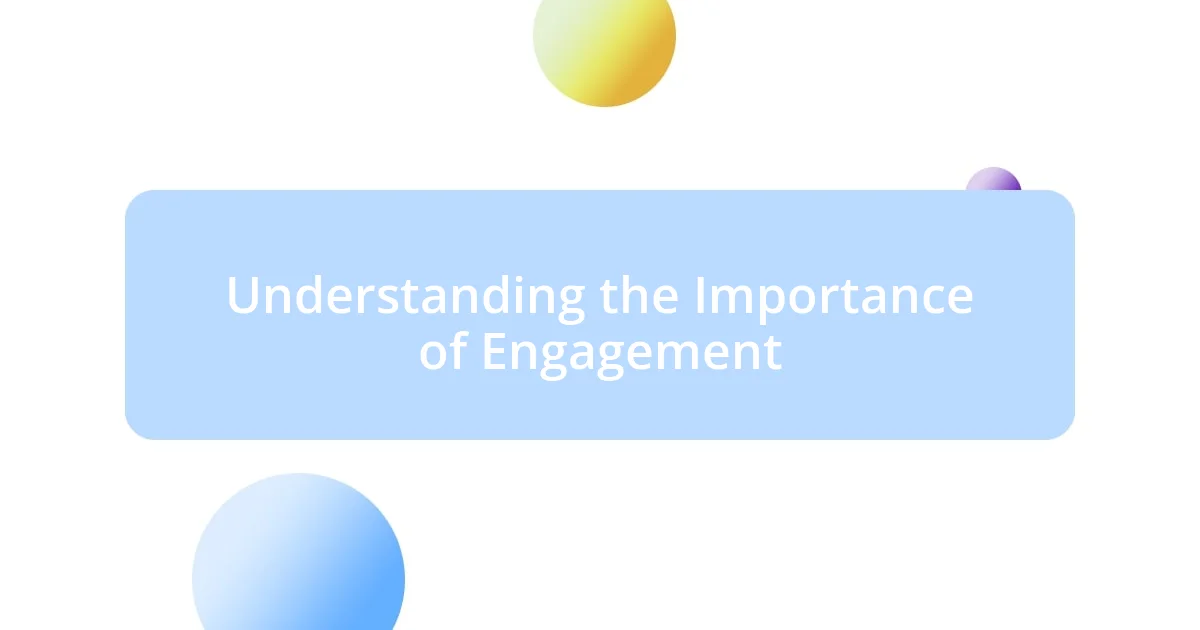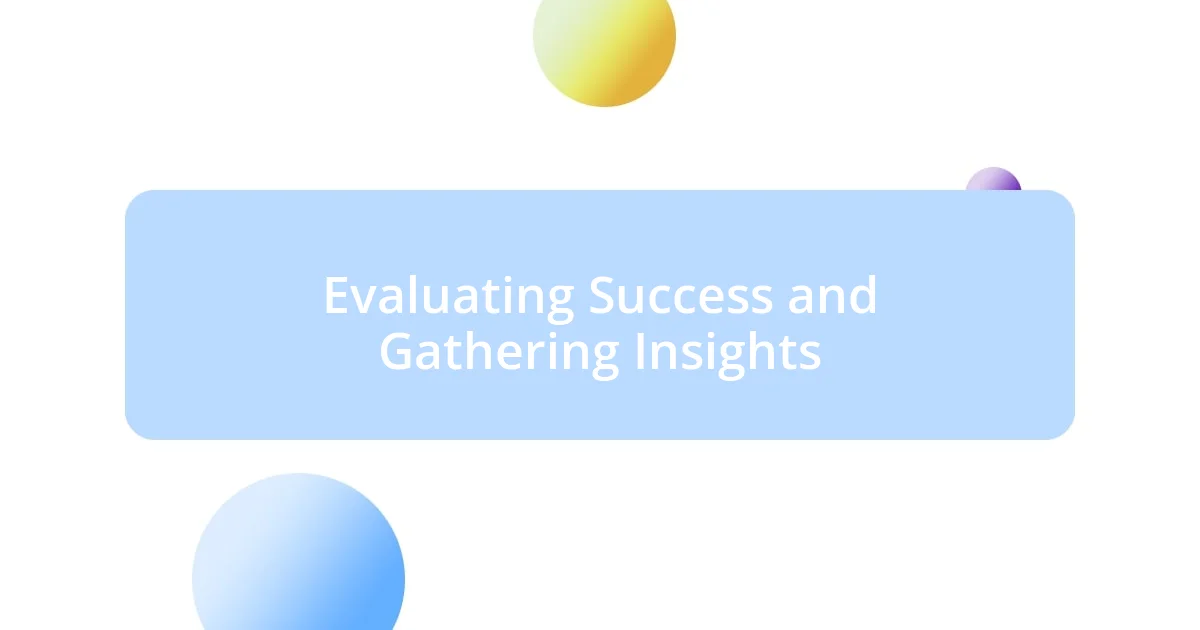Key takeaways:
- Engagement leads to lasting community connections and enhances parent involvement, creating a supportive environment for children.
- Identifying the target audience through demographics and interests helps tailor events for greater relevance and participation.
- Feedback and communication are crucial for continuous improvement, fostering a sense of community and ensuring parents feel valued and heard.

Understanding the Importance of Engagement
Engagement isn’t just a checkbox on a to-do list; it’s the heartbeat of any successful event. When I think back to the school fairs I organized, the energy was palpable when parents truly connected with what was happening around them. Why is this connection so vital? Because engaged parents not only support their children but also foster a thriving community where everyone feels valued.
From my experience, the reactions I saw at events—kids beaming with pride as their parents cheered them on—were absolutely priceless. It was as if those moments created a bond that transcended the event itself. Isn’t it fascinating how these shared experiences can ignite a passion for involvement that lasts far beyond a single day?
Moreover, engagement opens the door to meaningful conversations and collaborations. I remember a particular workshop where a parent approached me with an idea sparked during a discussion. That exchange led to an ongoing project that benefited our entire community. Can you imagine the impact of those small moments? They’re the stepping stones to something greater, reinforcing the idea that when parents participate, everyone wins.

Identifying Your Target Audience
Identifying your target audience is crucial to the success of any event. It’s not just about figuring out who might show up; it’s about understanding their motivations and interests. In one event I coordinated, we took the time to survey parents ahead of time, and I was amazed by what we discovered. Some were eager to be involved in educational activities, while others wanted to connect over social events. This awareness shaped our program, ensuring it truly resonated with attendees.
Here are key factors to consider when identifying your target audience:
- Demographics: Age, income, and education level can provide insights into what interests various parents.
- Interests: What hobbies or topics may engage them?
- Past Attendance: Look at who attended similar events in the past and their feedback.
- Community Needs: Understanding the needs or gaps within your community can highlight opportunities for engagement.
- Parent Involvement Level: Determine whether parents are typically hands-on or prefer supportive roles.
By focusing on these elements, you can tailor your event to meet the unique needs of your audience, ultimately creating a more engaging experience for all.

Choosing the Right Events
Choosing the right events is a critical step that can significantly impact parent engagement. In my experience, aligning event themes with parents’ interests fosters excitement and participation. For example, when we organized a science night featuring hands-on experiments, the thrilled responses from both parents and their children brought a burst of energy that I hadn’t anticipated.
Moreover, timing is equally important. I’ve noticed that scheduling events during busy school weeks is counterproductive. When we moved a family engagement night to a Friday, attendance surged! Parents shared how a relaxed end to the week made it easier for them to join in, ultimately transforming the event atmosphere into a lively celebration of community.
Lastly, the format of the event plays a vital role in encouraging parent participation. When I shifted from a traditional lecture style to interactive workshops, I witnessed a higher level of enthusiasm. Parents weren’t just passive listeners; they were collaborators, sharing ideas and experiences. This not only enhanced the event but also created a sense of belonging that echoed long after the activities wrapped up.
| Event Factor | Insights |
|---|---|
| Theme | Align with interests to boost excitement. |
| Timing | Choose less busy periods for higher attendance. |
| Format | Interactive formats increase collaboration and engagement. |

Creating Compelling Invitations
Creating compelling invitations is an art that I’ve come to appreciate through trial and error. When I designed invitations for our last community event, I made sure to craft messages that spoke directly to the parents’ interests. Instead of simply stating the event details, I added personal touches—like highlighting our featured activity, a family-friendly science demo, which made reading the invitation feel like a sneak peek into an exciting adventure.
I’ve learned that visuals play a crucial role as well. For instance, using bright, engaging graphics can transform a plain invite into something that catches the eye. One time, I included a photo of kids conducting an experiment, and the feedback was immediate—parents felt more drawn in and curious about what their children would experience. Have you ever considered how the look and feel of an invitation might influence someone’s decision to attend? Trust me, a well-designed invitation can ignite that spark of excitement that leads to higher attendance.
Finally, keep it personal. I like to include a short note from myself or a board member in the invitation, sharing why this event matters to us and how it could benefit their family. It might seem simple, but that touch of sincerity helps parents feel connected to the event’s purpose. Before sending out that last batch of invites, I always ask myself, “Would I want to attend this event after reading this?” If the answer isn’t a resounding “yes,” I know it’s time to revisit the drawing board.

Designing Interactive Activities
Designing interactive activities is where the magic truly happens. I remember hosting a family art night where parents and children were invited to collaborate on a large mural. The joy on their faces as they painted together—not just creating art, but memories—was incredible. Isn’t it fascinating how a simple paintbrush can transform an event into a bonding experience?
In another instance, we organized a scavenger hunt that led families throughout the school, encouraging them to engage with different exhibits. This approach not only sparked their curiosity but also facilitated conversations between parents who might otherwise have just exchanged pleasantries in passing. I realized that when fun meets purpose, it paves the way for deeper connections among attendees.
One key to success is flexibility. I’ve learned to adapt my activities based on the group’s energy levels. During one event, I noticed parents were a bit hesitant to engage. I quickly pivoted to a more hands-on, relaxed activity where they could explore at their own pace. This approach led to spontaneous laughter and collaboration. Have you ever thought about how being responsive to the crowd can elevate an event? I believe that tapping into the moment makes all the difference.

Encouraging Feedback and Communication
Encouraging feedback is essential for creating events that truly resonate with parents. At one event, I set up a feedback station with colorful sticky notes, inviting parents to share their thoughts. The reactions were incredible—some parents were genuinely surprised by the opportunity to leave their input. Seeing their comments unfold on the wall helped me realize just how much they valued the chance to be heard.
I also find that one-on-one conversations after the event can deepen connections. I often reach out to parents to chat about their experiences. During one such conversation, a mother mentioned that a particular workshop really helped her connect with her child’s learning style. That kind of insight not only helps me improve future events but also strengthens the relationship between home and school. Have you ever felt how those personal connections can really illuminate what works?
Moreover, I take time to communicate the changes made based on their feedback. When I announced that we were incorporating more family-centered activities in our next gathering because parents expressed a desire for that, the response was overwhelmingly positive. It shows them that their input matters and encourages ongoing communication. After all, wouldn’t you want to feel that your voice has a genuine impact? This ongoing dialogue transforms our events from mere gatherings into a community effort, where every parent feels like an essential part of the process.

Evaluating Success and Gathering Insights
Evaluating the success of an event involves more than just attendance numbers. I’ve found that post-event surveys can provide a wealth of information about how parents felt during the activities. For instance, after a family science night, I asked for insights on what families enjoyed the most. The results revealed that hands-on experiments truly sparked excitement, leading me to incorporate more interactive elements in future planning.
During one of my favorite events, I noticed a group of parents animatedly discussing their experiences while waiting in line for activities. Listening to their conversations not only made me smile but also highlighted the informal feedback we crave. It was a reminder that success is often measured in these shared moments—when parents connect and communicate with each other, they’re engaged and benefiting from the experience outside structured feedback mechanisms. How often have you walked away from an event recalling the connections made rather than the activities completed?
Analyzing this qualitative feedback can feel more like weaving a tapestry than just crunching numbers. I remember reflecting on a particular gathering where parents shared heartfelt stories about their children. Those snippets of conversation help me understand the emotional impact an event can have. They’re not just comments on a piece of paper; they’re windows into how well we’ve met their needs. Each event becomes an intricate dance of understanding and learning—how could we not treasure these insights to improve our next gathering?














